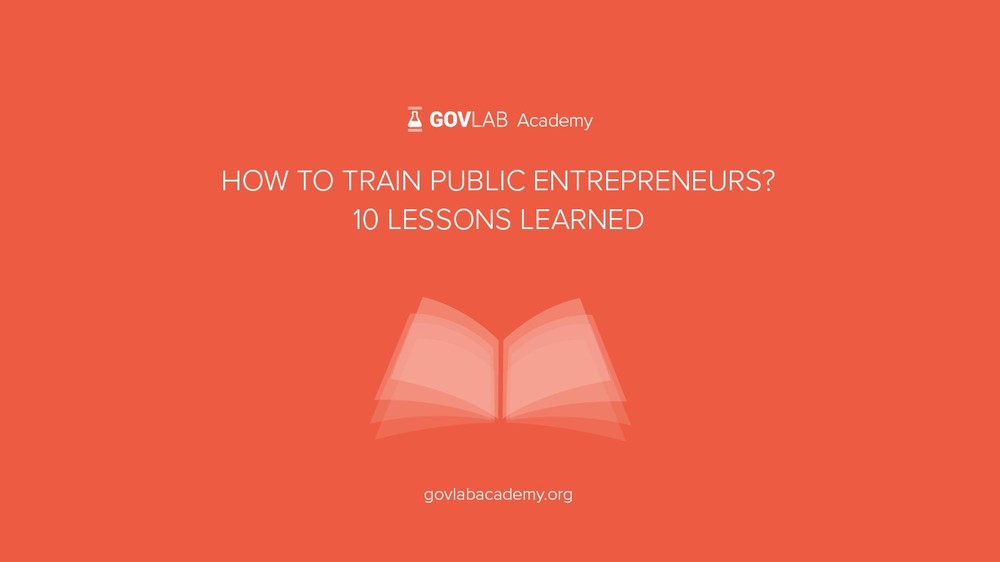
Cross-posted from Medium Over the last three years, in a series of Masters-level courses and online (and offline) workshops and coaching programs funded by the John S. and James L. Knight Foundation, The GovLab and its network of 25 world-class coaches and over 100 mentors helped 446 participants in more than a dozen US cities and thirty countries to take a public interest technology project from idea to implementation. In the process, we’ve learned a lot about the need for new ways of training the next generation of leaders and problem solvers
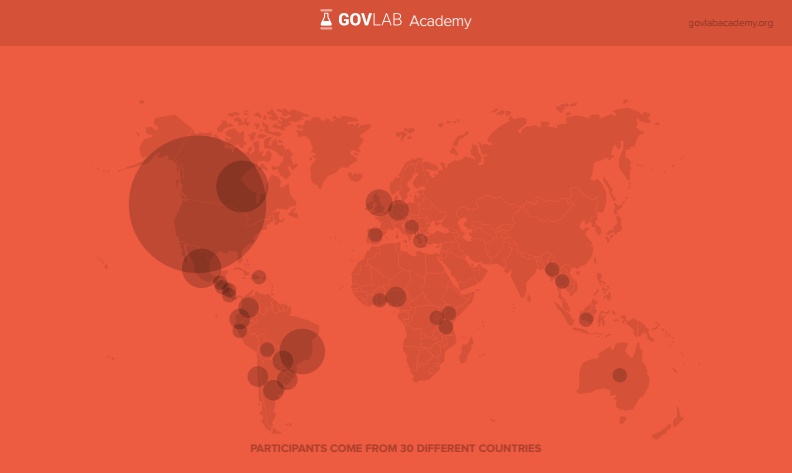
Our aim has been to aid public entrepreneurs — passionate and innovative people who wish to take advantage of new technology to do good in the world. That’s why we measure success, not by the number of participants in a class, but by the projects participants create and the impact those projects have on communities. Hence after fifteen years of doing face-to-face project based clinical learning with professional and student public entrepreneurs in engineering, law, communications and policy schools, we launched the GovLab Academy — an online “university” — to help more people cross the chasm from passionate idea to practical reality.
See the projects our alumni are working on:
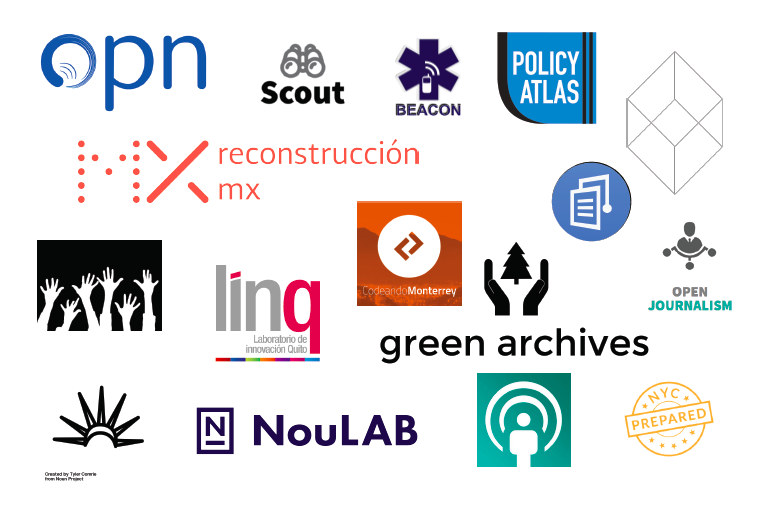 See all: http://govlabacademy.org/project-gallery.html
See all: http://govlabacademy.org/project-gallery.html
What We Are Learning
Lesson 1: There is growing, and unmet, demand for training a new kind of public servant: the public entrepreneur.
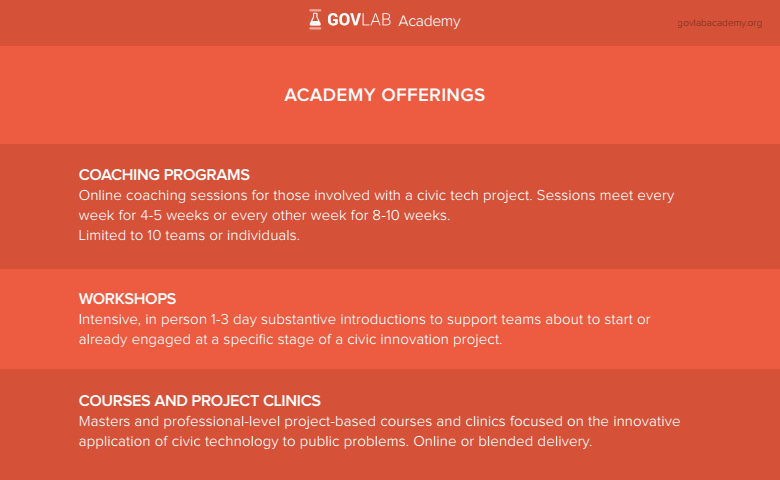
The GovLab Academy, http://thegovlabacademy.org
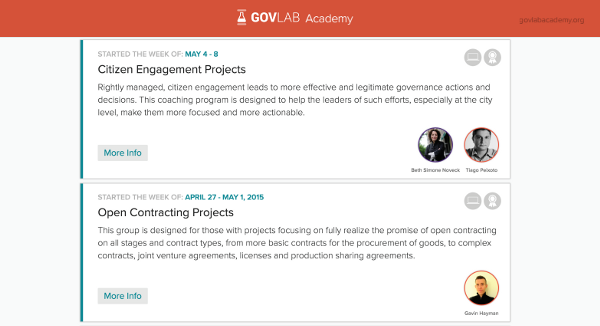 Academy Coaching Programs, http://govlabacademy.org/coaching-programs.html
Academy Coaching Programs, http://govlabacademy.org/coaching-programs.html
In response to the diverse demand from public officials, social entrepreneurs and students underserved by traditional professional school education, the GovLab evolved the Academy from a typical MOOC platform for delivering bundled and unbundled content about governance innovations, such as crowdsourcing and open data, into a hands-on program for training and coaching focused on helping those working in the public interest take a project from idea to implementation. Thanks to support from the Knight Foundation, we have been able to offer these coaching programs at no cost to participants.
Deep questions remain about the ability for many areas of government and civil society to identify, cultivate and retain individuals with the necessary skills for success in a world increasingly driven by information technology. — NetGain
Lesson 2: Tap the distributed supply of talent and expertise to accelerate learning.
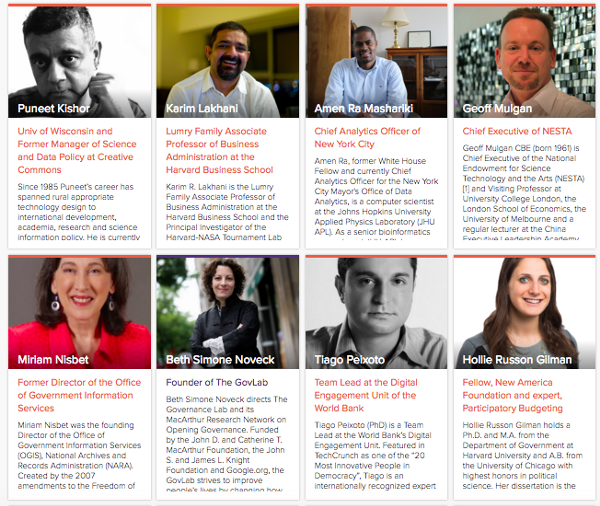
Unlike a traditional university where participants are constrained by the limits of a single faculty, an online training program offers a platform for making diverse know-how available across institutional boundaries. We draw upon experts with deep skills and extensive networks to help would-be innovators, among them faculty from New York University, Harvard, Arizona State, Columbia, Stanford, USC and other universities (many of whom, like me, also replicated the curriculum with their brick and mortar students) as well as practitioners and those with extensive practice experience.
Imagine being a social innovator in California or Caracas and learning first hand from Samir K. Brahmachari, creator of the global tuberculosis Open Source Drug Discovery crowdsourcing project, or Francois Grey, Coordinator of the Citizen Cyberscience Centre, Geneva and leader of the citizen science movement. Imagine being a government official in Quito or Dallas and getting help from Alan Kantrow, former head of Knowledge Management at McKinsey.
With ease, the Internet brings the mountain to Mohammed to enable people to learn from those with experience as well as credentials. By awarding our own certificates, we are able to bring together faculty from across many institutions who otherwise would not have been able to collaborate.
Lesson 3: Create new methods for training public entrepreneurs to solve problems.

After much experimentation and measurement, we have come to focus on an approach to learning that includes:
- Rigorous up-front diagnosis of impediments to implementation that allow us to customize learning;
- Emphasis on specific and evidence-based problem definition to ensure that the project solves a well-defined problem;
- A combination of subject-matter and skills-based training to address both deficits in knowledge about innovation and in know-how about the means to apply that knowledge to one’s own project;
- A heavy dose of peer-to-peer support where similarly situated public entrepreneurs counsel, support, and puzzle through challenges together;
- Mentoring and coaching from those with a track record of leading successful social change;
- High-quality original and curated content, including eight different pedagogical tools. Why have one size fits all syllabi when we can use both human curation and expert systems like the Crowdsourcing Design Advisor to automate the process of giving people manageable materials customized to their needs?
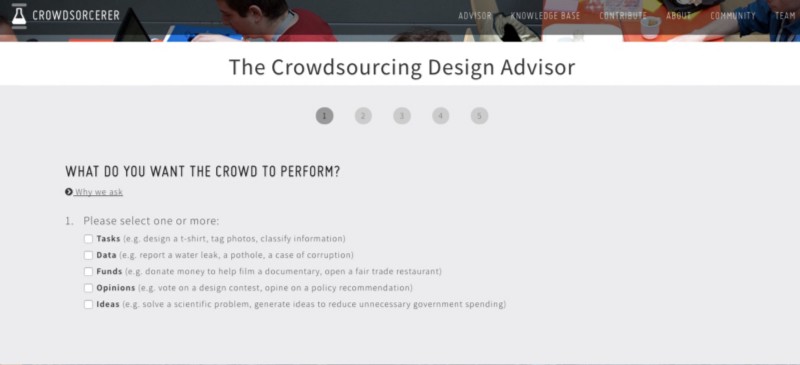
Lesson 4: Develop tools to help public interest innovators “cross the chasm” from idea to implementation.
The Business Model Canvas is a template to capture a business in a single and simple diagram. It is designed to help a startup plan how to cross the cash poor “valley of death” from concept to product launch. But when you are passionate about solving a public problem, there are also common deathtraps, including:
- Defining the problem clearly enough to develop a solution that really works;
- Knowing how to navigate bureaucracies, legal regimes, and institutions to get things done;
- Developing compelling materials to persuade the naysayers — what we like to call the “no machines” — within those bureaucracies;
- Identifying how to measure what works.

Based on our experience teaching civic innovators, the GovLab developed the Public Projects Canvas, an interactive worksheet to help those working on civic projects for the common good become more impactful. It is the tool participants find the most helpful. The Canvas is available in multiple languages and is shareable, editable and commentable by team members, peers, coaches and mentors.
Lesson 5: Teach collaboration and partnering for change.
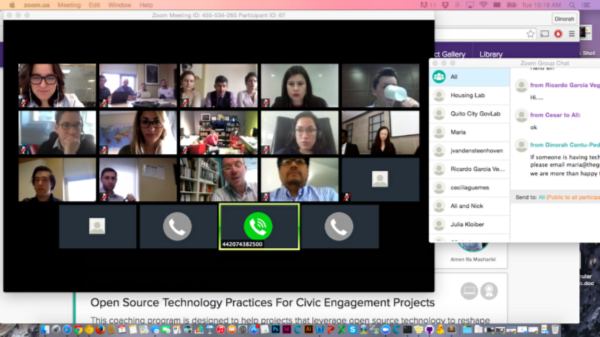
Peer-to-peer learning is a significant component of how people learn to be effective. In the Academy, we bring together a dozen teams and individuals working on a common challenge for mutual learning and support. Unlike in a traditional university, where the emphasis is on individual work product, in the Academy we pair people with mentors whose deep networks and subject matter expertise help them find partners and powerful champions to get things done. We encourage participants to put ego to one side and to “write the letter they want someone else to send” to make things happen in the real world.
Lesson 6: In order to be successful, public entrepreneurs must be able to define the problem — a skill widely lacking.
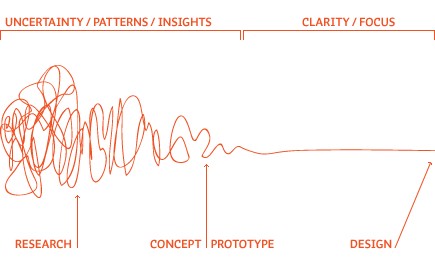
Effective solutions are developed only when one has a clear definition of the problem to be tackled. Hence our pedagogy emphasizes problem definition and we frequently help people rewrite their problem statements three or more times, using such tools as the GovLab Academy Canvas and The Problem Definition ToolKit.
If you are looking for a class that will help you think more deeply and practically about a problem you’d like to solve for, I encourage you to check out SPPT and GovLab’s other course offerings. Through the class, I learned how to better articulate a problem, communicate my ideas and generate support. — Academy Participant
I am completely addicted to the class. The readings and videos have been excellent, and I’ve enjoyed the chats the various online participants have had during classes. I was actually yelling at the screen some when Dr. Kantrow was discussing problem identification..his comments resonated with me because I’ve seen so many government professionals skip problem identification and analysis all together [sic] and just jump right into brainstorming project ideas. This was especially true when homeland security funding hit the table and, rather than devising a plan for wisely investing it, it seemed to become a race for local governments to just grab chunks by writing up project after project, with no real consideration for the problems, their magnitude, or the extent to which the military-style toy they wanted to buy (for example) would mitigate the problem. Grrrrr… — Academy Participant
Lesson 7: Connecting innovators and alumni with one another generates a lasting public infrastructure that can help solve problems more effectively.
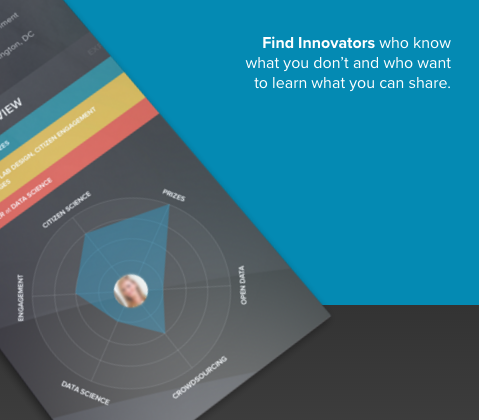
To be effective, people need to do more than read about new ways of working. They need and want to connect with individuals who have done it before. So when a Congressional staffer, for example, wants to post a new bill online for public comment, she wants to talk to those in Iceland or Colombia about their experiences — good and bad — with posting draft constitutions and laws online. To support this desire for peer-to-peer learning, we built an expert network called the Network of Innovators (NoI). NoI is a skill sharing platform that matches public entrepreneurs with complementary skills. Participants are encouraged to join the Network and “pay it forward” by helping others.
Lesson 8: Pedagogical priorities include making problem solving more data driven and evidence based.
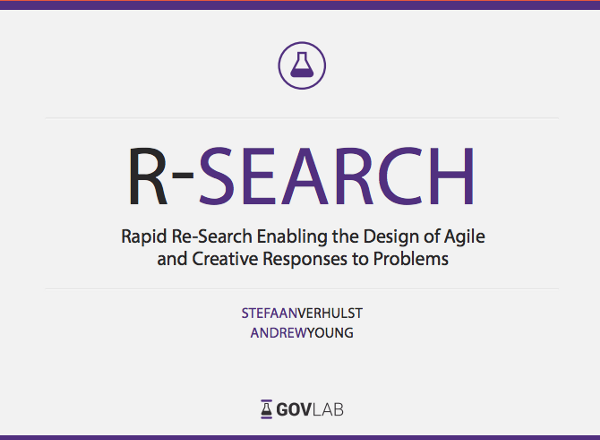
Getting stuff done in government does not afford the luxury of academic style research. But experimenting with taxpayer dollars also cannot be undertaken without evidence of what works. To help everyone learn how to use data and evidence to define their problem and understand possible solutions, we started to develop a toolkit and guidance on Rapid Results Research to help teams get smarter faster. Such bench research skills are supported by accelerating learning from others with related experience.
Lesson 9: The demand and supply are global — requiring a global mindset and platform to learn what has worked elsewhere and why.

Effective projects get developed when people learn from peers in other cities and countries. So we are bringing together people working on common problems from around the world into conversation to challenge one another’s assumptions.
It was a great use of technology to bring us all together via Zoom. It opened up several interesting discussions that exposed me to ideas about FOIA and my project on state/local transparency/secrecy. It exposed me to people I probably would never have met otherwise, whose ideas and expertise I plan to tap. And it helped me get a broader understanding of how a project such as mine might proceed. — Academy Participant
For example, in a course led by Clay Johnson, teams from New York City, Mexico City, Pittsburgh and London were so eager to keep talking that they requested to extend the program by four weeks as they all tried to improve their governments’ tech procurement processes.
Lesson 10: Collaboration and coordination among anchor organizations is key to meeting the demand and coordinating the supply.
We cannot do this work alone. Success comes from collaboration between partners with commitments to solving the world’s hardest problems. Here are some of the ways we are collaborating:

Combining Coaching and Prizes — For those sponsoring a prize-backed challenge, such as One.Org, the Citizen Cyberscience Centre, and the Crowdcrafting platform, who are trying to stimulate the use of citizen science to achieve the Sustainable Development Goals, we offer the coaching that helps the winners take an innovation, like an app, from a cool idea to an implementable project.
Creating New Communities of Practice — Working with the Organization of American States, which is investing in building the next generation of innovative leaders in Latin America, we are coaching these OAS Fellows to realize the vision for their projects. We have also partnered with Nesta and MindLab to coach a cohort of new public lab practitioners.
Agile Networks of Expertise — Through a curated call for help to global experts, the GovLab Academy is helping the City of Quito to prepare for the possible explosion of the Cotopaxi volcano by quickly assembling dozens of global experts to provide advice and mentoring, leading to the development of a new suite of citizen reporting tools.
University for the Public Good: Making a Dent in the Universe
Our next step is to replicate and scale what works to make a concerted effort to tackle hard problems.
Imagine what a new kind of university dedicated to the public good might look like. Even as we launch new coaching programs to help more people become agents of change, our bigger goal is to make a dent in really hard problems from reforming the criminal justice system to advancing humanitarian interventions to fighting inequality by empowering more people to become effective public entrepreneurs.
To do so, we want to multiply project coaching and mentoring initiatives — focused on solving specific problems and enabling people to use innovative techniques to do so — and to create the scalable platforms and interventions that provide sustained engagement for many more public entrepreneurs to the end of catalyzing real change in more communities.
The world’s national, state and local governments don’t have the right digital skills in the right quantities to meet the challenges of the coming century. This is a Big Problem. — _A Manifesto for Public Technology, Tom Steinberg, founder of mySociety.org_
In the process of creating our homespun “public good university,” we also hope to convince traditional universities to change how they teach. At NYU Tandon School of Engineering, we already offer Capstone programs for graduate students focusing on public entrepreneurship and using the same methods. We need more engineering programs focusing on public interest problems, more law and public policy schools including technology in their toolkit, and more cross-over between these disciplines.
But we don’t have to wait until we rebuild ancient universities and hidebound degree programs when we can create new pop-up universities for social good like the Academy.
For more about the Academy read our one-pager, our slides and our full report.
